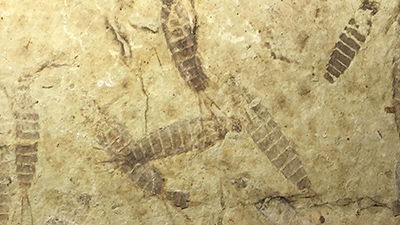Prehistoric Ink
BBC News: “Ink Found in Jurassic-Era Squid” Scientists cannot only write about amazing fossil discoveries; now, they can write with one!
Paleontologists led by Phil Wilby of the British Geological Survey encountered an unexpected fossil find in Wiltshire recently: a remarkably well-preserved squid ink sac. The fossil was discovered in a site long known for housing many fossils of other soft-bodied organisms.
“It is difficult to imagine how you can have something as soft and sloppy as an ink sac . . . inside a rock that is 150 million years old”
Phil Wilby, British Geological Survey
What is startling is that the ink sac was intact and filled with ink. And although the ink had solidified, it was found to be essentially the same chemical structure as other squid ink, was re-liquefied with a chemical solution, and was then used to sketch a picture of the creature along with its Latin name. (See a photograph of the sketch on the Daily Mail website.) Yet based on the rock layers, the creature’s age is said to be some 150 million years old!
“It is difficult to imagine how you can have something as soft and sloppy as an ink sac fossilized in three dimension[s], still black, and inside a rock that is 150 million years old,” conceded Wilby. The Daily Mail report on the find adds that “the odds of finding something as delicate as a squid’s ink sac intact after so long are put at a billion to one.”
The entire discovery is a resounding confirmation of the creation model of paleontology, for several reasons:
- Remarkable preservation—The fossil intactness of the soft-bodied organism would have required rapid burial, such as by catastrophic process. Wilby referenced the Medusa effect, wherein an organism is “turned to stone soon after death.” Such fossils “can be dissected as if they are living animals—you can see the muscle fibers and cells.”
- Mass burial—The fossil squid is one of many soft-bodied fossils found at the site, reinforcing the scenario of catastrophic burial (though other paleontologists posit the idea of poisonous algae).
- Fully developed organism—Although the fossil is thought to be from the extinct, squid-like creature Belemnotheutis antiquus, the important point is that the fossil, like nearly all others, is easily identifiable as from a fully developed member of one of the created kinds—not a transitional form.
Though the fossil site has been known about since the nineteenth century, its exact location was lost until Wilby’s team rediscovered it. So perhaps the site will yield more fossil surprises!
For more information:
- The World’s a Graveyard
- Get Answers: Fossils, Living Fossils
Remember, if you see a news story that might merit some attention, let us know about it! (Note: if the story originates from the Associated Press, Fox News, MSNBC, the New York Times, or another major national media outlet, we will most likely have already heard about it.) And thanks to all of our readers who have submitted great news tips to us.
(Please note that links will take you directly to the source. Answers in Genesis is not responsible for content on the websites to which we refer. For more information, please see our Privacy Policy.)
Recommended Resources

Answers in Genesis is an apologetics ministry, dedicated to helping Christians defend their faith and proclaim the good news of Jesus Christ.
- Customer Service 800.778.3390
- Available Monday–Friday | 9 AM–5 PM ET
- © 2026 Answers in Genesis






